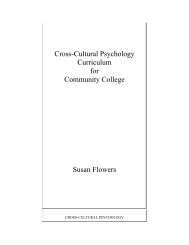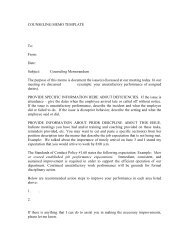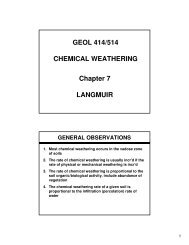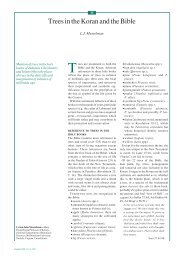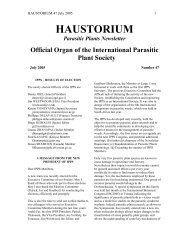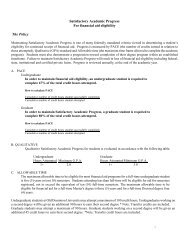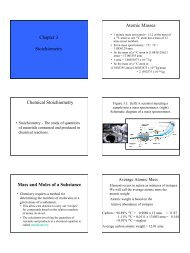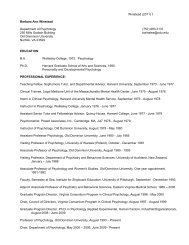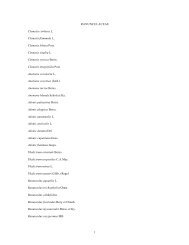HAUSTORIUM
HAUSTORIUM
HAUSTORIUM
You also want an ePaper? Increase the reach of your titles
YUMPU automatically turns print PDFs into web optimized ePapers that Google loves.
<strong>HAUSTORIUM</strong> 61 10<br />
LITERATURE<br />
* indicates web-site reference only<br />
Abad Domínguez, A.B., Torres Martínez, G., Montealegre<br />
Lara, A.L. and Barrera, O. 2005. (Detection of seeds of<br />
quarantined weed species in Mexico in observance of<br />
NOM-043-FITO-1999.) (in Spanish) XVII Congreso de<br />
la Asociación Latinoamericana de Malezas (ALAM) I<br />
Congreso Iberoamericano de Ciencia de las Malezas, IV<br />
Congreso Nacional de Ciencia de Malezas, Matanzas,<br />
Cuba, 8 al 11 de noviembre del 2005: 359-364.<br />
[Describing the official Mexican standard ‘Specifications<br />
to prevent the introduction of quarantined weed species<br />
in Mexico’ listing 64 species in 21 families, including<br />
Orobanchaceae, Scrophulariaceae, Convolvulaceae.]<br />
Abella, S.R., Prengaman, K.A., Embrey, T.M., Schmid,<br />
S.M., Newton, A.C. and Merkler, D.J. 2012. A<br />
hierarchical analysis of vegetation on a Mojave Desert<br />
landscape, USA. Journal of Arid Environments 78: 135-<br />
143. [Noting the use of Krameria grayi as an ecological<br />
indicator.]<br />
Adaramoye, O., Amanlou, M., Habibi-Rezaei, M., Pasalar,<br />
P. and Moosavi-Movahedi, A. 2012. Methanolic extract<br />
of African mistletoe (Viscum album) improves<br />
carbohydrate metabolism and hyperlipidemia in<br />
streptozotocin-induced diabetic rats. Asian Pacific<br />
Journal of Tropical Medicine 5(6): 427-433. [Extract of<br />
‘V. album’ (in Turkey?) has anti-diabetic and antihyperlipidemic<br />
effects in STZ-diabetic rats.]<br />
Adnan Amin and Khan, M.A. 2011. In vitro bactericidal and<br />
bacteriostatic potential of ingredients of traditional<br />
medicine obtained from Kacha area (River Indus) district<br />
D.I. Khan, KPK, against human bacterial pathogens.<br />
Pakistan Journal of Botany 43(5): 2613-2617. [Ximenia<br />
americana among 5 species showing antimicrobial<br />
activity.]<br />
Aichner, M., Oberauner, L., Liebminger, S., Fürnkranz, M.<br />
and Berg, G. 2012. Volatile organic compounds of plantassociated<br />
bacteria to reduce microbial contamination on<br />
clean room textile. In: Pertot, I., Elad, Y., Gessler, C.<br />
and Cini, A. (eds) IOBC/WPRS Bulletin 78: 381-384.<br />
[Volatile organic compounds from natural antagonistic<br />
endophytes from mistletoe (presumably Viscum album)<br />
inhibited the growth of Stenotrophomonas maltophilia.]<br />
Akhilesh Kumar, Pandey, V.C. and Tewari, D.D. 2012.<br />
Documentation and determination of consensus about<br />
phytotherapeutic veterinary practices among the Tharu<br />
tribal community of Uttar Pradesh, India. Tropical<br />
Animal Health and Production 44(4): 863-872.<br />
[Recording ‘great agreement among informants’ for the<br />
use of Cuscuta reflexa.]<br />
Alder, A., Jamil, M., Marzorati, M., Bruno, M., Vermathen,<br />
M., Bigler, P., Ghisla, S., Bouwmeester, H., Beyer, P.<br />
and Al-Babili, S. 2012. The path from β-carotene to<br />
carlactone, a strigolactone-like plant hormone. Science<br />
(Washington) 335(6074): 1348-1351. [A breakthrough<br />
paper on the elucidation of the strigolactone biosynthetic<br />
pathway. The catalytic function of DWARF27 was<br />
determined to be the isomerisation of trans to cis-ßcarotene.<br />
The latter serves as substrate for CCD7 and the<br />
resulting apocarotenoid as substrate for CCD8. This 3-<br />
step pathway results in the formation of the highly<br />
surprising compound carlactone that already has the D-<br />
ring that is so characteristic for strigolactones and<br />
stimulates the germination of Striga and<br />
Orobanche/Phelipanche.]<br />
Ali, I.H.H. and El-Yazal, M.A. 2011. Efficacy of glyphosate<br />
herbicide against dodder and its impact on some<br />
biochemical parameters on host plant Nerium oleander<br />
L. and a survey of host range of some ornamentals at<br />
Fayoum. Bulletin of Faculty of Agriculture, Cairo<br />
University 62(4): 494-502. [Recording C. campestris on<br />
11 host species in Egypt and noting its selective control<br />
on oleander by glyphosate at 200 and 400 ppm.]<br />
Aly, R. 2012. Advanced technologies for parasitic weed<br />
control. Weed Science 60(2): 290-294. [Reviewing the<br />
need for alternative biotechnology-methods and<br />
describing the generation of transgenic tobacco plants<br />
expressing a cecropin peptide (sarcotoxin IA), under the<br />
control of the inducible HMG2 promoter and showing<br />
enhanced resistance to Phelipanche aegyptiaca. (see also<br />
Haustorium 59 pp 2-3).]<br />
Almehdar, H., Abdallah, H.M., Osman, A.M.M. and Abdel-<br />
Sattar, E.A. 2012. In vitro cytotoxic screening of<br />
selected Saudi medicinal plants. Journal of Natural<br />
Medicines 66(2): 406-412. [In studies with human breast<br />
cancer (MCF7), hepatocellular carcinoma (HEPG2), and<br />
cervix cancer (HELA) cells, ‘interesting cytotoxic<br />
activity’ was observed for extracts of Phragmanthera<br />
austroarabica.]<br />
Amico, G.C., Vidal-Russell, R., García, M.A., and Nickrent<br />
D.L. 2012. Evolutionary history of the South American<br />
mistletoe Tripodanthus (Loranthaceae) using nuclear and<br />
chloroplast markers. Systematic. Botany 37: 218-225.<br />
[Results from a combined analysis of ITS and plastid<br />
genes showed the Tripodanthus flagellaris clade<br />
(including T. belmirensis) as sister to T. acutifolius<br />
which was composed of eastern and Andean clades.]<br />
Amri, M., Abbes, Z., Youssef, S.B., Bouhadida, M., Salah,<br />
H.B. and Kharrat, M. 2012. Detection of the parasitic<br />
plant, Orobanche cumana on sunflower (Helianthus<br />
annuus L.) in Tunisia. African Journal of Biotechnology<br />
11(18): 4163-4167. [Recording the first occurrence of O.<br />
cumana on sunflower in Tunisia and discussing the need<br />
for quarantine and control measures to reduce its<br />
spread.]<br />
Atera, E.A., Itoh, K., Azuma, T. and Ishii, T. 2012. Farmers'<br />
perspectives on the biotic constraint of Striga<br />
hermonthica and its control in western Kenya. Weed<br />
Biology and Management, 12: 53–62. [Striga<br />
hermonthica is regarded as a major constraint to maize,<br />
sorghum, and finger millet production and is increasing<br />
in the region. Local control measures include handpulling,<br />
crop rotation, and intercropping, but are not




